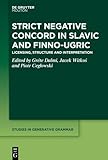Strict Negative Concord in Slavic and Finno-Ugric : Licensing, Structure and Interpretation / ed. by Gréte Dalmi, Jacek Witkoś, Piotr Cegłowski.
Material type: TextSeries: Studies in Generative Grammar [SGG] ; 148Publisher: Berlin ; Boston : De Gruyter Mouton, [2024]Copyright date: 2024Description: 1 online resource (X, 314 p.)Content type:
TextSeries: Studies in Generative Grammar [SGG] ; 148Publisher: Berlin ; Boston : De Gruyter Mouton, [2024]Copyright date: 2024Description: 1 online resource (X, 314 p.)Content type: - 9783110754797
- 9783110754865
- 9783110754834
- 491.8045
- online - DeGruyter
- Issued also in print.
| Item type | Current library | Call number | URL | Status | Notes | Barcode | |
|---|---|---|---|---|---|---|---|
 eBook
eBook
|
Biblioteca "Angelicum" Pont. Univ. S.Tommaso d'Aquino Nuvola online | online - DeGruyter (Browse shelf(Opens below)) | Online access | Not for loan (Accesso limitato) | Accesso per gli utenti autorizzati / Access for authorized users | (dgr)9783110754834 |
Frontmatter -- Acknowledgements -- Contents -- List of abbreviations -- List of figures -- List of tables -- 1 Slavic and Finno-Ugric in the typology of Negative Concord languages -- 2 Negative Concord in East Slavic: Looking into the core of the Bagel Problem -- 3 What ellipsis teaches us about Negative Concord -- 4 Neg-words and NPI’s in Czech -- 5 Negation and Negative Concord in Slovenian -- 6 Negative indefinites, Clausal Negation and Strict Negative Concord in Vepsian: Oscillating between Finnic and Russian -- 7 Licensing negative indefinites in Hungarian: A purely cartographic approach -- 8 Negative Concord in Mari -- 9 Negative Concord in Selkup: An overview -- 10 Strict Negative Concord in Slavic and Finno-Ugric: Concluding remarks -- Index
restricted access online access with authorization star
http://purl.org/coar/access_right/c_16ec
Expressing negation is a universal property of all human languages. There is considerable variation, however, in the exact ways negation materializes cross-linguistically. Strict Negative Concord differs both from the Negative Polarity Item strategy and the Asymmetric Negative Concord strategy in that the sentence becomes negative only if the sentence negator is overtly expressed in it, irrespective of how many negative expressions are used. The central aim of this book is to describe Strict Negative Concord in some Slavic and Finno-Ugric languages. In particular, the volume gives an insight into the forms Strict Negative Concord manifests itself in Russian, Polish, Czech, Slovenian (Slavic), Finnish, Hungarian, Mari (Finno-Ugric) and the closely related Selkup (Samoyedic) to a wide linguistic community. It aims to create a platform for comparison with similar phenomena in well-described European languages.
Issued also in print.
Mode of access: Internet via World Wide Web.
In English.
Description based on online resource; title from PDF title page (publisher's Web site, viewed 20. Nov 2024)


